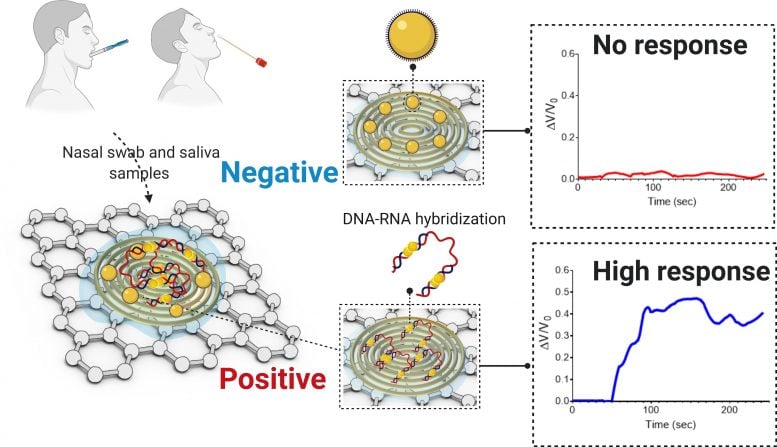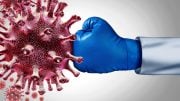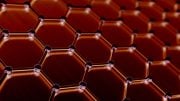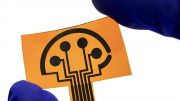As the COVID-19 pandemic continues to spread across the world, testing remains a key strategy for tracking and containing the virus. Bioengineering graduate student, Maha Alafeef, has co-developed a rapid, ultrasensitive test using a paper-based electrochemical sensor that can detect the presence of the virus in less than five minutes. The team led by professor Dipanjan Pan reported their findings in ACS Nano.
“Currently, we are experiencing a once-in-a-century life-changing event,” said Alafeef. “We are responding to this global need from a holistic approach by developing multidisciplinary tools for early detection and diagnosis and treatment for SARS-CoV-2.”
There are two broad categories of COVID-19 tests on the market. The first category uses reverse transcriptase real-time polymerase chain reaction (RT-PCR) and nucleic acid hybridization strategies to identify viral RNA. Current FDA-approved diagnostic tests use this technique. Some drawbacks include the amount of time it takes to complete the test, the need for specialized personnel and the availability of equipment and reagents. The second category of tests focuses on the detection of antibodies. However, there could be a delay of a few days to a few weeks after a person has been exposed to the virus for them to produce detectable antibodies.
In recent years, researchers have had some success with creating point-of-care biosensors using 2D nanomaterials such as graphene to detect diseases. The main advantages of graphene-based biosensors are their sensitivity, low cost of production and rapid detection turnaround. “The discovery of graphene opened up a new era of sensor development due to its properties. Graphene exhibits unique mechanical and electrochemical properties that make it ideal for the development of sensitive electrochemical sensors,” said Alafeef. The team created a graphene-based electrochemical biosensor with an electrical read-out setup to selectively detect the presence of SARS-CoV-2 genetic material.
There are two components to this biosensor: a platform to measure an electrical read-out and probes to detect the presence of viral RNA. To create the platform, researchers first coated filter paper with a layer of graphene nanoplatelets to create a conductive film. Then, they placed a gold electrode with a predefined design on top of the graphene as a contact pad for electrical readout. Both gold and graphene have high sensitivity and conductivity which makes this platform ultrasensitive to detect changes in electrical signals.
Current RNA-based COVID-19 tests screen for the presence of the N-gene (nucleocapsid phosphoprotein) on the SARS-CoV-2 virus. In this research, the team designed antisense oligonucleotide (ASOs) probes to target two regions of the N-gene. Targeting two regions ensures the reliability of the sensor in case one region undergoes gene mutation. Furthermore, gold nanoparticles (AuNP) are capped with these single-stranded nucleic acids (ssDNA), which represent an ultra-sensitive sensing probe for the SARS-CoV-2 RNA.
The researchers previously showed the sensitivity of the developed sensing probes in their earlier work published in ACS Nano. The hybridization of the viral RNA with these probes causes a change in the sensor’s electrical response. The AuNP caps accelerate the electron transfer and when broadcasted over the sensing platform, results in an increase in the output signal and indicates the presence of the virus.
The team tested the performance of this sensor by using COVID-19 positive and negative samples. The sensor showed a significant increase in the voltage of positive samples compared to the negative ones and confirmed the presence of viral genetic material in less than five minutes. Furthermore, the sensor was able to differentiate viral RNA loads in these samples. Viral load is an important quantitative indicator of the progress of infection and a challenge to measure using existing diagnostic methods.
This platform has far-reaching applications due to its portability and low cost. The sensor, when integrated with microcontrollers and LED screens or with a smartphone via Bluetooth or wifi, could be used at the point-of-care in a doctor’s office or even at home. Beyond COVID-19, the research team also foresees the system to be adaptable for the detection of many different diseases.
“The unlimited potential of bioengineering has always sparked my utmost interest with its innovative translational applications,” Alafeef said. “I am happy to see my research project has an impact on solving a real-world problem. Finally, I would like to thank my Ph.D. advisor professor Dipanjan Pan for his endless support, research scientist Dr. Parikshit Moitra, and research assistant Ketan Dighe for their help and contribution toward the success of this study.”
Reference: “Rapid, Ultrasensitive, and Quantitative Detection of SARS-CoV-2 Using Antisense Oligonucleotides Directed Electrochemical Biosensor Chip” by Maha Alafeef, Ketan Dighe, Parikshit Moitra and Dipanjan Pan, 20 October 2020, ACS Nano.
DOI: 10.1021/acsnano.0c06392










Very Interesting.
Progress on quick detection after infection.
Biosensors measure Bio-electrical signals . Electric currents flow from a anode to to a cathode and flow can be detected!
Detection after 5 minutes means that if neutralizing agents if available are embedded in the skin of the infectee/potential infectee , the problem infecting agent can be squashed /quashed before viral load becomes uncontrollable and causes the death of the mortal.
Question. Why only two regions of the N-Gene? Thousands of mutations of C-19 have occurred since arrival of the C-19 in Humans. What if both regions undergo Mutations?
Anyway , well done . Testing on Steroids needs to be accompaned witth Cures on Steroids for known infecting agents and also , future Viruses and Future Pandemics need to be anticipated and Prevention of Infection should be the key drivers of future research . Lead Indicators are far superior than lag indicators. However, when Inffectivity of the new Virus / Pathogen/bacteria is extremely High , then fixing the problem on the fly with integrated soutions of detecttion and cure is essental , So once again — Well done.